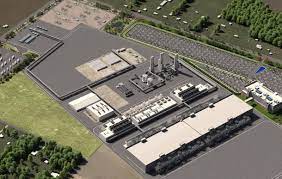In an effort to address the global shortage of chips powering everything from phones to cars to home appliances, chipmaker Intel announced Friday that it will invest $20 billion to build a new factory in Ohio. The announcement also demonstrates the commitment of the enormous corporation to producing critical technology goods in the United States.
By opening new facilities and bringing expertise to the area, associated businesses that assist chip manufacturing may also result in the development of a new technology cluster in central Ohio.
Two upcoming factories, or fabs, according to Intel, will support both its new “foundry” division, which will produce chips made by other companies, as well as its own line of CPUs. Numerous custom-designed chips are produced by existing chip foundries, primarily in Asia. TSMC, often known as Taiwan Semiconductor Manufacturing Co., presently controls the market.
Intel CEO Patrick Gelsinger stated during a White House event that the future production facility seeks to address a variety of demands. He said that in addition to easing supply chain strains, chips produced there will also improve U.S. national security and create more tech jobs in the area.
The two facilities, which will be located on a 1,000-acre property in Licking County, just east of Columbus, are anticipated to generate 7,000 construction employment in addition to 3,000 corporate jobs, many of which will be highly skilled. According to Intel and municipal and state officials, the plant will support tens of thousands of extra employment for partners and suppliers.
A former Intel executive who returned to the corporation as CEO in 2021, Gelsinger, claimed that “a semiconductor factory is not like other factories.” “It’s more like a little city that supports a thriving neighborhood of suppliers, service providers, and ancillary businesses. This may be compared to a magnet for the entire tech sector.
The $52 billion package, which is seeking House approval and would invest in the chip industry to assist ensure more production takes place in the United States, was promoted by President Joe Biden using Intel’s Ohio announcement.
In his speech at the White House, Biden remarked, “We are going to invest in America.” We are putting money into American labor. These computer chips in particular will have “Made in America” stamped on them.
Production is anticipated to start this year and go online by the end of 2025. In order to assist the facility create jobs; the firm is also investing an additional $100 million in a pipeline for education. Six additional factories may bring the total investment to above $100 billion over the next ten years, according to Gelsinger.
According to Forrester analyst Glenn O’Donnell, Intel said the Intel 18A is one of the items it will manufacture in Ohio and is “among the most advanced chips ever built.” These are probably going to be utilized in the high-end computers that video game aficionados enjoy using and that are required for the data centers owned by IT behemoths like Amazon and Microsoft.
Gelsinger said that the Ohio facility would also provide specialized chips for autos, which are in high demand from American customers and government officials, as well as other goods like mobile devices.
The company’s other production lines should experience lesser strain thanks to Intel’s Ohio facility.
However, because the chips would still be shipped to Asia for assembling and packaging, increasing the production of computer chips domestically won’t completely shield the sector from supply chain snarls and shortages, according to Nina Turner, an IDC research analyst.
After years of being heavily dependent on Asia for the supply of computer chips, the U.S. and Europe’s vulnerability to shortages of the essential components emerged as they started to recover economically from the pandemic.
According to the Semiconductor Industry Association, the U.S. market share for chip manufacturing has dropped from 37% in 1990 to 12% now, and shortages are now a possible issue.
Chip shortages have made it difficult for American manufacturers to build cars, and last year Toyota overtook General Motors as the top-selling automaker in the country for the first time.
The United States and Europe are actively working to increase chip production capacity and lessen dependency on producers, who are currently primarily situated in Asia. Businesses in the semiconductor industry have also been attempting to diversify their operations to prevent bottlenecks brought on by issues — such as a pandemic lockdown or natural disaster — in a particular area.
Last year, a number of chipmakers expressed interest in growing their American operations if the American government could make it simpler to construct chip factories. In November, Samsung announced plans to erect a $17 billion facility outside Austin, Texas.
Legislators have urged House and Senate leaders to properly fund a measure intended to solve the scarcity of semiconductor chips, as Biden alluded to. The $52 billion CHIPS for America Act, which permits domestic investment in semiconductor factories, is something they want Congress to fully fund.
Due to the fact that eight out of ten chips are produced in Asia, the chip scarcity has not only negatively impacted the American economy but also the nation’s security infrastructure, according to senators.
The scale of Intel’s Ohio complex will rely on the approval of the federal incentives requested by the Biden administration and Ohio lawmakers, executives made plain on Friday.
Keyvan Esfarjani, Intel’s senior vice president of manufacturing, stated in a statement that “the breadth and pace of Intel’s expansion in Ohio will depend primarily on funding from the CHIPS Act.”
The Intel project is equal to the 1977 agreement that brought Honda to central Ohio, where it today employs more than 14,000 people, as the largest single private investment in Ohio’s history.
Ohio Governor Mike DeWine said in a statement that “Intel’s new facilities will be transformative for our state, producing thousands of good-paying jobs in Ohio manufacturing strategically essential semiconductors.”
According to DeWine, Ohio won the project over 40 other states. State officials promised to cooperate with the business in order to supply skilled personnel who would require anything from a two-year community college education to advanced degrees.
The Santa Clara, California-based company Intel revealed plans to invest $20 billion in two new plants in Arizona last year. Additionally, it is requesting financial aid from the European Union to construct a sizable plant somewhere in the continent. Last month, it announced plans to invest $7.1 billion to upgrade its decades-old manufacturing facility in Malaysia, which accounts for 10% of the company’s global workforce.
Additionally, Intel maintains facilities in China, Vietnam, Ireland, and Israel.
According to market research by Gartner Inc., Intel is the world’s No. 2 semiconductor maker, coming in behind market leader Samsung Electronics of South Korea with $76.1 billion in revenue last year.
Amazon, Facebook, and Google have all built data centers in the area, adding high-tech jobs to Central Ohio, which has long been recognized for a predominantly white-collar workforce in banking and insurance.

















